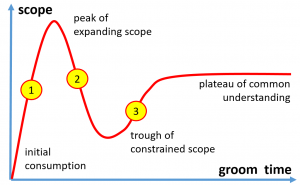I was reading about the Gartner Hype Cycle and realized the same curve could be applied to Agile Backlog Groom (or simply Grooming). Grooming is the process for an agile scrum team to absorb new work and add details. Every piece of work, no matter the size, follows this generic evolution. That is, the following discussion is Epic, Story, etc. agnostic and if you are a water-scrum-fall champion, this applies to you too.
Agile Backlog Groom
The groom session goal is for the scrum team to move from initial introduction to common understanding. This common understanding of the scope is a cornerstone of agile scrum and further, Mike Willis explains the cone of uncertainty. The team moves from confusion (conscious or not) to tangible scope. After grooming, the team can estimate and commit to the work and this is applied equally to requirement specification step of a waterfall model as suggested by Philip Wang.
PS: At any point the scrum team can (should) delay this activity pending inquiry or action.
1 Expand the “What”
On initial consumption, the team discovers “the what.” The team learns of the business request and asks questions to make sure they understand the vision. This first phase is a real work out session. Let the ideas rip!
The team members rapidly expand the total scope and include the“Nice to have’s” too. Everyone on the scrum team is busy, especially the supporters, for example, Architect, DB, UX, SME, SEC, OPS, etc.
Nothing is outstanding at the termination of this phase. We are at “scope peak.” Consider edge cases, tech debt, and refactoring, not just nominal flows. In a verbal contract, the team members all agree that the story could not mean anything more. The Product Owner has done her part by actively ranking the pieces/parts, for example through use of MoSCoW (must, should, could, would).
2 Constrain the “What”
After the story pieces/parts have expanded [beyond belief]. Then the team brings it back to a minimum viable addition to the software baseline. The “Musts” definitely remain and the “Shoulds” are nearby.
They put the scrum car into reverse, so that the scope boundary tightens down. Stories spin off by decomposition methods (Christiaan Verwijs has some good ideas). Now, only the most necessary use cases, test scenarios, and edge cases, etc. remain.
The important thing is that all team members are moving to a common understanding. The team’s cone of uncertainty has narrowed.
3 Add the “How”
The team hits the “scope trough” and the scope has bottomed out. Then they begin to kick around “the how.” There is an expansion here – adding necessary dependencies, refactoring, documentation, databases, technical prototyping, design styling, test assets, etc.
This is the development engineering feedback to the Product Owner. If it is an easy get based on the engineering approach, the team can add a “Could” or “Would.” Most importantly, the cone of uncertainty, that is, the level of mismatched understanding, has narrowed even more.
Go Build It
The team has reached a “plateau of understanding.” Everyone involved knows [near] exactly what is needed and how they will get there. The story details are quite essential, understood, and bounded. These steps help to manage expectations. The scrum team can estimate with confidence, commit to the MoS’s and excite with the CoW’s.
A mature scrum team can groom a story in ~15 minutes, but clearly this depends on the work size. Using the hype cycle, the team sees agile backlog groom transitions. If they are so inclined, groom efficiency can be measured with a clock.


